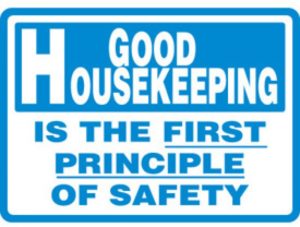March Safety Tip
Housekeeping & Hazards
Housekeeping in a work setting is crucial to safe workplaces. It can help prevent injuries and improve productivity and morale, as well as make a good first impression on visitors. It also can help a company avoid potential fines for non-compliance.
The practice extends in every setting and experts agree that all workplace safety programs should incorporate housekeeping, and every worker should play a part. Here are tips for effective workplace housekeeping.
Prevent slips, trips and falls
Slips, trips and falls were the second leading cause of nonfatal occupational injuries or illnesses involving days away from work. OSHA’s Walking-Working Surfaces Standard (1910.22(a)) states that all workplaces should be “kept clean and orderly and in a sanitary condition.” The rule includes passageways, storerooms and service rooms. Floors should be clean and dry. Drainage should be present where “wet processes are used.”
Develop and implement housekeeping procedures using appropriate cleaners especially areas with oils and grease. The wrong kind of cleaning protocol will spread the slipperiness around rather than getting it up and off the floor.
Tips to help prevent slip, trip and fall incidents:
- Report and clean up spills and leaks.
- Keep aisles and exits clear of items.
- Consider installing mirrors and warning signs to help with blind spots.
- Replace worn, ripped or damage flooring.
- Consider installing anti-slip flooring in areas that can’t always be cleaned.
- Use drip pans and guards.
In addition, provide mats, platforms, false floors or “other dry standing places” where useful, according to OSHA. Every workplace should be free of projecting nails, splinters, holes and loose boards.
Employers should audit for trip hazards, and encourage workers to focus on the task at hand.
Eliminate fire hazards
Employees are responsible for keeping unnecessary combustible materials from accumulating in the work area. Combustible waste should be “stored in covered metal receptacles and disposed of daily,” according to OSHA’s Hazardous Materials Standard (1910.106).
Here are precautionary measures for fire safety from the National Safety Council:
- Keep combustible materials in the work area only in amounts needed for the job. When they are unneeded, move them to an assigned safe storage area.
- Store quick-burning, flammable materials in designated locations away from ignition sources.
- Avoid contaminating clothes with flammable liquids. Change clothes if contamination occurs.
- Keep passageways and fire doors free of obstructions. Stairwell doors should be kept closed. Do not store items in stairwells.
- Keep materials at least 18 inches away from automatic sprinklers, fire extinguishers and sprinkler controls. The 18-inch distance is required, but 24 to 36 inches is recommended. Clearance of 3 feet is required between piled material and the ceiling. If stock is piled more than 15 feet high, clearance should be doubled. Check applicable codes, including Life Safety Code, ANSI/NFPA 101-2009.
- Hazards in electrical areas should be reported, and work orders should be issued to fix them.
Prevent falling objects
Protections such as a toe board, toe rail or net can help prevent objects from falling and hitting workers or equipment.
- Stack boxes and materials straight up and down to keep them from falling.
- Place heavy objects on lower shelves, and keep equipment away from the edges of desks and tables.
- Refrain from stacking objects in areas where workers walk, including aisles.
- Keep layout in mind so workers are not exposed to hazards as they walk through areas.
Determine frequency
All workers should participate in housekeeping, especially in terms of keeping their own work areas tidy, reporting safety hazards and cleaning up spills, if possible.
- Every worker has a role in housekeeping. If they see something is becoming a problem, they need to report it.
- Before the end of a shift, workers should inspect and clean their workspaces and remove unused materials. This dedication can reduce time spent cleaning later, experts say.
- How much debris or contaminants the workplace releases can help determine the frequency of housekeeping. A company should have a mixture of deep cleaning and more frequent, lighter cleaning that involves sweeping and responding to spills, Norton said.
For more tips on keeping a safe workplace, see the resources in the member’s section in www.wcti.info or contact your WCTI Loss Control Consultant.

